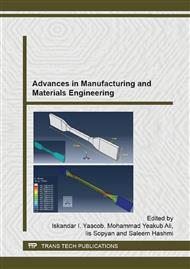p.446
p.450
p.454
p.458
p.462
p.468
p.472
p.476
p.480
Development of Catalytic Converter Using Non-Precious Metals
Abstract:
This paper shows the uses of low cost metal for the development of catalytic converters. While bringing down the cost, attention must be paid on the performance capability of the catalytic converter. The objective of this work is to develop and design a low cost catalytic converter using copper as the main catalyst in the catalyst system. Copper powder was chosen as the alternative catalyst to reduce the use of precious group metals (PGMs) platinum, palladium, and rhodium. A spark ignition engine’s catalytic converter has to perform the oxidation of CO, oxidation of HC and reduction of NOx simultaneously in order to satisfy its performance requirement. These three chemical reactions are taking place simultaneously in a three way catalytic converter. To investigate the chemical kinetics and fluid flow characteristics of a catalytic converter, simulations have been carried out using COMSOL. From COMSOL MULTIPHYSICS, catalytic converter’s velocity field and pressure distribution have been simulated. From COMSOL REACTION ENGINEERING LAB, NO and CO concentration from a catalytic converter kinetics model have been plotted. NO and CO conversion for different air to fuel ratio had shown that for rich mixture, NO reduction reaches its maximum but CO oxidation is at its minimum. In lean mixture, CO oxidation is at its maximum but NO reduction is at its minimum. Simulations have shown the actual characteristics of the catalytic converter performance. The flow throughout catalytic converter and the backpressure have successfully determined and the catalyst conversion efficiency also shown clearly.
Info:
Periodical:
Pages:
462-467
Citation:
Online since:
July 2015
Authors:
Keywords:
Price:
Сopyright:
© 2015 Trans Tech Publications Ltd. All Rights Reserved
Share:
Citation:


